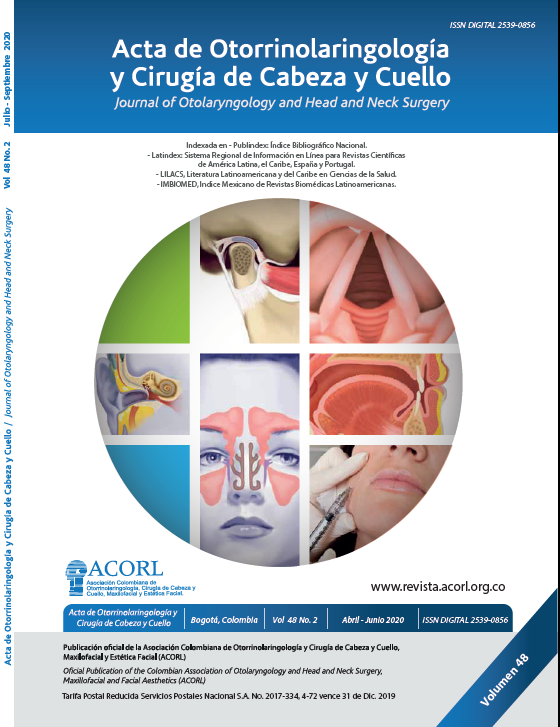Peripheral eosinophilia as a factor of tomographic severity in chronic rhinosinusitis
Main Article Content
Abstract
Introduction: Chronic rhinosinusitis (CRS) is one of the most prevalent diseases worldwide. Eosinophils play an important role in the generation of a chronic nasosinusal inflammatory process secondary to the generation of a Th2 maladaptive response and changes in the nasal microbiota.
Objectives: To determine if peripheral eosinophilia can be used as a predictor of tomographic severity in patients with chronic rhinosinusitis.
Methods: An observational cross-sectional study with an analytical component was performed in patients with a diagnosis of CSR who had a eosinophil count in their clinical record. The sample size was 74 individuals.
Results: Peripheral eosinophilia was established as a tomographic severity factor, finding that for each increase of 100 eosinophils in blood, the total score of the Lund-Mackay tomographic scale would increase by 1 point. This pattern was equally concordant in patients with polyps and asthma, with increases in total scores of 4 and 5 points respectively, with respect to patients who do not present these pathologies.
Conclusion: The use of peripheral eosinophilia as a predictor of severity could be very useful for the medical community. This biomarker can result in potential cost savings by eliminating the need for repeated medical treatments in patients who initially have an increased risk of severe nasosinusal disease.
Downloads
Article Details
Este artículo es publicado por la Revista Acta de Otorrinolaringología & Cirugía de Cabeza y Cuello.
Este es un artículo de acceso abierto, distribuido bajo los términos de la LicenciaCreativeCommons Atribución-CompartirIgual 4.0 Internacional.( http://creativecommons.org/licenses/by-sa/4.0/), que permite el uso no comercial, distribución y reproducción en cualquier medio, siempre que la obra original sea debidamente citada.
eISSN: 2539-0856
ISSN: 0120-8411
References
Beule A. Epidemiology of chronic rhinosinusitis, selected risk factors, comorbidities, and economic burden. GMS Curr Top Otorhinolaryngol Head Neck Surg. 2019;14(1865-1011). doi:
1055/s-0034-1396869
Fokkens W, Lund V, Mullol J, Bachert C, Alobid I, Baroody Fet al. EPOS 2012: European position paper on rhinosinusitis and nasal polyps 2012. A summary for otorhinolaryngologists. Rhinology journal. 2012;50(1):1-12. doi:10.4193/Rhino50E2
Rosenfeld R, Piccirillo J, Chandrasekhar S, Brook I, Ashok Kumar K, Kramper M et al. Clinical Practice Guideline (Update).Otolaryngology–Head and Neck Surgery. 2015;152(4):598-609. doi: 10.1177/0194599815574247
Kim D, Cho S. Emerging Endotypes of Chronic Rhinosinusitis and Its Application to Precision Medicine. Allergy, Asthma & Immunology Research. 2017;9(4):299. doi: 10.4168/aair.2017.9.4.299
Yildirim A, Yüce S, Gümüş C, Kunt T. Peripheral eosinophilia and its relation with CT scores in chronic rhinosinusitis KBBForum:Elektronik Kulak Burun Boğaz ve Baş Boyun Cerrahisi Dergisi. 2005;4(2):81-83.
Hamilos D, Leung D, Wood R, Meyers A, Stephens J,Barkans J, et al. Chronic hyperplastic sinusitis: Association
of tissue eosinophilia with mRNA expression of granulocytemacrophage colony-stimulating factor and interleukin-3.Journal of Allergy and Clinical Immunology. 1993;92(1 Pt1):39-48. doi: 10.1016/0091-6749(93)90035-e
Baroody FM, Hughes CA, Mcdowell P, Hruban R, Zinreich SJ, Naclerio RM. Eosinophilia in Chronic
Childhood Sinusitis. Archives of Otolaryngology - Head and Neck Surgery. 1995;121(12):1396-402. doi: 10.1001/
archotol.1995.01890120054010
Al Ghamdi K, Ghaffar O, Small P, Frenkiel S, Hamid Q. IL-4 and IL-3 expression in chronic sinusitis: relationship with cellular infiltrate and effect of topical corticosteroid treatment.J Otolaryngol. 1997;26(3):160-166.
Harlin S, Ansel D, Lane S, Myers J, Kephart G, Gleich G. Aclinical and pathologic study of chronic sinusitis: The role of the eosinophil. J Allergy Clin Immunol. 1988;81(5 Pt 1):867-875. doi:10.1016/0091-6749(88)90944-x
Appenroth E, Rüdige A, Müller H, Völklein C, Schrott-Fisher A. Activated and Non-activated Eosinophils in Patients with Chronic Rhinosinusitis. Acta Oto-Laryngologica.1998;118(2):240-2. doi: 10.1080/00016489850154964
Ikeda K, Shiozawa A, Ono N, Kusunoki T, Hirotsu M, Homma H, et al. Subclassification of chronic rhinosinusitis with nasal polyp based on eosinophil and neutrophil. The Laryngoscope.2013;123(11):E1-9. doi: 10.1002/lary.24154
Tecimer SH, Kasapoglu F, Demir UL, Ozmen OA, Coskun H,Basut O. Correlation between clinical findings and eosinophil/neutrophil ratio in patients with nasal polyps. European Archives of Oto-Rhino-Laryngology. 2014;272(4):915–21.doi: 10.1007/s00405-014-3174-4
Lou H, Meng Y, Piao Y, Wang C, Zhang L, Bachert C. Predictive Significance of Tissue Eosinophilia for Nasal Polyp Recurrence in the Chinese Population. American Journal of Rhinology & Allergy. 2015;29(5):350-6. doi: 10.2500/ajra.2015.29.4231
Drake VE, Rafaels N, Kim J. Peripheral blood eosinophilia correlates with hyperplastic nasal polyp growth. International Forum of Allergy & Rhinology. 2016;6(9):926-34. doi:10.1002/alr.21793
Newman LJ. Chronic sinusitis. Relationship of computed tomographic findings to allergy, asthma, and eosinophilia.JAMA. 1994;271(5):363-7. doi: 10.1001/jama.271.5.363
Bhattacharyya N, Fried MP. Peripheral eosinophilia in the diagnosis of chronic rhinosinusitis. American Journal of Otolaryngology. 2001;22(2):116-20. doi: 10.1053/ajot.2001.22570
Bryson J, Tasca R, Rowe-Jones J. Local and systemic eosinophilia in patients undergoing endoscopic sinus surgery for chronic rhinosinusitis with and without polyposis. Clinical Otolaryngology and Allied Sciences. 2003;28(1):55-8. doi:10.1046/j.1365-2273.2003.00666.x
Bresciani M, Paradis L, Roches AD, Vernhet H, Vachier I,Godard P, et al. Rhinosinusitis in severe asthma. Journal of Allergy and Clinical Immunology. 2001;107(1):73-80. doi:10.1067/mai.2001.111593
Zadeh MH, Banthia V, Anand VK, Huang C. Significance of Eosinophilia in Chronic Rhinosinusitis.American Journal of Rhinology. 2002;16(6):313-7. doi:10.1177/194589240201600606

